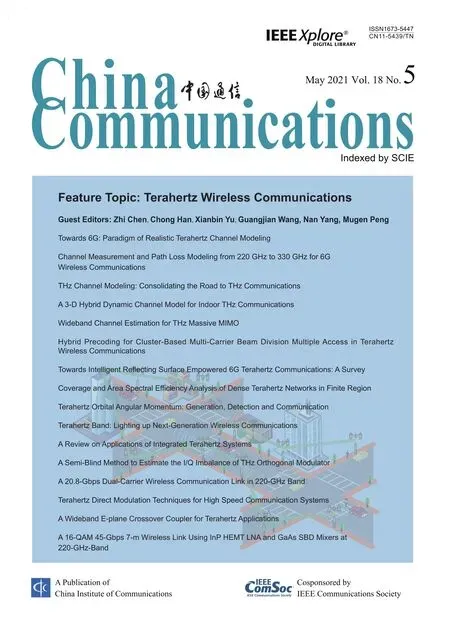Terahertz Direct Modulation Techniques for High-speed Communication Systems
Tianchi Zhou,Yaxin Zhang,2,*,Bo Zhang,*,Hongxin Zeng,Zhiyong Tan,Xilin Zhang,Lan Wang,Zhi Chen,Juncheng Cao,Kaijun Song,Ziqiang Yang
1 University of Electronic Science and Technology of China,Chengdu,China
2 Yangtze Delta Region Institute(Huzhou),University of Electronic Science and Technology of China,Huzhou 313001,China
3 Key Laboratory of Terahertz Solid State Technology,Shanghai Institute of Microsystem and Information Technology,Chinese Academy of Sciences,865 Changning Road,Shanghai 200050,China
4 Center of Materials Science and Optoelectronics Engineering,University of Chinese Academy of Sciences,Beijing 100049,China
Abstract:Terahertz communication technology can provide abundant frequency resources,strong confidentiality,antijamming capability,communication tracking capability and the ability to achieve highspeed data transmissions and can serve as an important technical method for high-speed communications in the future.Among these terahertz communication technologies,terahertz direct modulation technology is a key means to achieve low system complexity and power consumption.In this paper,a review and outlook of terahertz direct modulation technology are proposed from the aspects of high-electron-mobilitytransistor-based terahertz direct modulation,parallelswitch terahertz direct modulation,diode-based terahertz direct modulation,quantum cascade laser-based terahertz direct modulation and new-material-based terahertz direct modulation.We hope through this paper that more readers can gain knowledge about the development and challenges of terahertz direct modulation technology for high-speed communication systems,thus promoting the development of high-speed terahertz communication technology based on direct modulation.
Keywords:THz communication,THz direct modulation,HEMT,switches,diode,QCL,new-material
I.INTRODUCTION
Terahertz(THz)communication technology refers to technology that uses electromagnetic waves located in the terahertz frequency band(electromagnetic waves in the 0.1-10 THz band,with wavelengths between 3-0.03 mm;1 THz=1000 GHz)as the carrier wave to carry out the wireless transmission of massive amounts of information.Due to the special location of the terahertz frequency band in the transition region between the macroelectromagnetic waveband and the microwave photonics band,terahertz communication technology has rich spectrum resources,resistance to interference and intercept characteristics,strong communication tracking capture capabilities,and the ability to achieve high data rate transmissions,making it capable of transmitting large amounts of data and providing an important pathway towards high-speed,large-capacity wireless communications.It can become an important technical method for largecapacity real-time wireless data transmission in the future.Great application prospects in the fields of nextgeneration mobile communications,space communications and private communications can be found in terahertz communication technology.
In recent years,with the increasing attention on sixth-generation mobile communication technology(6G),terahertz wireless communication technology has been recognized as a potential key technology for 6G.In the future era of 6G,3D imaging and sensor networks will be widely used,and with the development of AI and machine learning technologies,there will be increasing communication requirements among machines[1].The communication data rate requirements of a single user may increase to 1 Tbps.High-speed communication technologies such as terahertz communication technology are needed to achieve such a rate under a scenario of ultraefficient short-distance communications.In 2019,the World Radio Conference(WRC-19)claimed the available spectrum resources for the application of active terrestrial wireless service in the terahertz band for the first time,and the upper limit of the available spectrum resources for active wireless services was raised to 450 GHz,which provides a basic resource guarantee for the development and application of a global terahertz communication industry.
Microwave,millimeter-wave and optical technologies are instructive to terahertz communication technology due to the unique position of the terahertz spectrum.Since Japan reported a communication demonstration system of a 120 GHz carrier frequency and 10 Gbps speed in 2006[2](known as”the landmark achievement of wireless communication”),terahertz wireless communication has developed rapidly and become a global focus of research.In recent years,terahertz communication technology has been developing towards higher speed,higher atmospheric window frequency,lower power consumption,improved integration and practical application.At present,terahertz wireless communication technology has formed three kinds of wireless communication mechanisms:mixing modulation THz communication technology,microwave photonics THz communication technology and THz direct modulation communication technology,which have been developing in parallel for different application scenarios.The data rate of terahertz communication systems has also increased gradually.In 2013,the Karlsruhe Institute of Technology in Germany developed a 100 Gbps terahertz communication system with a communication distance of up to 20 m[3],which attracted much attention and was regarded as a notable research result at that time.In 2016,Zhejiang University in China improved terahertz communication system speed to 160 Gbps[4],which was considered byNATURE PHOTONICSas a research highlight of ultrafast wireless links in the field of terahertz science.
Using multiplexing technology,the terahertz communication speed has reached 200 Gbps[5]or even more than 1 Tbps[6]in recent years.However,because of the demand for miniaturized terahertz communication in terms of power consumption and system complexity,fully digitalized,miniaturized and highly simplified high-speed terahertz communication systems have attracted increasing attention in recent years,particularly for terahertz direct modulation communication systems.
Unlike mixing or microwave photonics THz communication systems based on the mechanism of frequency conversion,a terahertz direct modulation communication system controls the THz radio frequency(RF)waves directly,which can greatly simplify communication system architecture.In terms of high baseband frequency,the traditional architecture of analog to digital/digital to analog(AD/DA)conversion can be discarded by using a field programmable gate array(FPGA)and comparator,which can load baseband digital signals directly to the terahertz carrier.This can greatly reduce the complexity of the baseband signal processing circuit along with the power consumption of the whole system.The lightweight system architecture of a terahertz direct communication system can provide the foundation for future local area network or even body area network communications.
However,the most difficult problem in direct terahertz modulation communication systems is the direct modulation of terahertz carrier signals.To address this problem,this article reviews the key technologies of terahertz direct modulation,including highelectron-mobility-transistor-based THz direct modulation,parallel-switch THz direct modulation,diodebased THz direct modulation,quantum cascade laserbased THz direct modulation,and new-material-based THz direct modulation.The difficulties in high-speed terahertz direct modulation technology are also analyzed.The developing direction of terahertz direct modulation technology is discussed based on the development of present terahertz direct modulation technologies and future communication demands.We begin with two traditional mechanisms of communication systems.
II.TERAHERTZ COMMUNICATION SYSTEMS
2.1 Mixing Modulation Terahertz Communication Systems
A mixing modulation terahertz communication system can be developed from traditional microwave and millimeter-wave communication systems.Such a system uses mixing technology according to the basic principle of nonlinear frequency conversion.By applying terahertz Schottky mixing diodes,the baseband service is upconverted onto the terahertz carrier frequency.In terms of mathematical principles,the mixer has a nonlinear relation function of voltage and current.Based on a Taylor series expansion,the output signal can be transferred into the sum of the input signal to the power of different nonnegative integers.By using a feature that the higher order term contains the product of different frequency components,frequency cross-components are introduced,and the add operation for frequency is realized.Thus,a low-frequency baseband intermediate frequency(IF)signal is loaded onto the high-frequency terahertz carrier signal to realize high-speed modulation communication.This scheme can realize high-order modulation of the amplitude and phase of terahertz waves through the direct processing of low-frequency signals.A mixing modulation terahertz communication system has high bandwidth utilization and is capable of combining a mature low-frequency electromagnetic wave device and digital device technology with terahertz RF device technology through mixing.For example,the baseband signal can be converted to an intermediate frequency,and then narrowband amplification and waveform shaping can be implemented on the intermediate frequency signal.After that,frequency conversion can be applied to the radio frequency to achieve highperformance multichannel transmission.The classic system architecture is shown in Figure 1(a).At the transmitter,the frequency multiplication and amplification link is used to generate a local oscillator(LO)signal.Through the mixer,the IF signal carrying information is added with several times the LO signal frequency and converted into an RF signal.To ensure low-frequency conversion loss,a terahertz mixer usually adopts a mixing diode with a small anode size.For this reason,it is difficult to operate under a high power level,and the RF signals generated by mixers are usually within 100μW.After the mixing process,terahertz power amplifier technology is applied to amplify the terahertz RF signal to a milliwatttens of milliwatts power level.At the receiver end,a low-noise amplifier is used to amplify the terahertz wave transmitted through the wireless channel.Then,the amplified signal enters the mixer for downconversion demodulation to realize data transmission service.Based on this architecture,data transmission speeds greater than 100 Gbps has been achieved by using terahertz discrete semiconductor devices and siliconbased chips[7],and the operating frequency can reach 500 GHz[8].The advantage of using discrete devices is that terahertz RF active devices such as Schottky diodes exhibit better performance,and their smaller junction capacitance enables them to have a higher response rate of electromagnetic waves,which can meet the needs of long-distance and high-speed data transmission[9].
Zhongqian Niu et al.reported a 220 GHz communication system based on a mixing link in 2020[10].To improve the baseband bandwidth,two sets of ADCs-DACs are used in this design.The signal generated by one DAC is mixed with the 6.9 GHz signal and then added to the signal generated by another DAC.After that,the signal contains information generated by two DACs at a frequency of 220 GHz using a terahertz mixer;the structure of the system is shown in Figure 1(b).The communication system adopts 16QAM modulation and realizes a 12.8 Gbps real-time data rate within a 20 m range,which is a sufficient bandwidth for 8K video transmission services.The received constellation can be seen in Figure 1(c).This design optimizes the baseband of the communication system and solves the problem of IF signal processing caused by the overly large absolute bandwidth of the terahertz frequency band.
In addition,a mixing modulation terahertz communication system for near distance transmission can also be realized through silicon-based chip technology.For example,in 2016,Kosuke Katayama et al.proposed a terahertz communication system based on a mixer using six channels[11].The modulation mode is 32QAM,and the EVM of each channel is less than 9% rms,as shown in Figure 1(e).Each channel can achieve a data rate of 17.5 Gbps,so a total rate of 105 Gbps can be achieved at approximately 300 GHz.
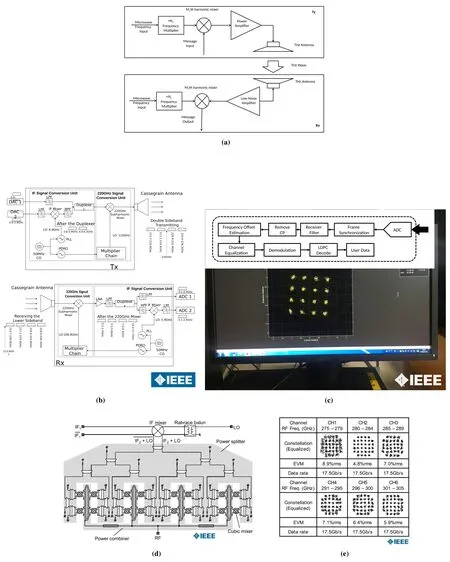
Figure 1.(a)shows the classic system architecture of the transmitter and receiver of a mixing modulation terahertz communication system.Frequency multiplier LO links are usually needed in both the transmitter and receivers.(b)and(c)show the system architecture and experimental constellation diagram of[10].(d)and(e)show the transmitter architecture and experimental constellation diagram and EVM analysis of six individual channels at a data speed of 17.5 Gbps in[11].
This design built a 300 GHz CMOS transmitter,which solves the problem of limited CMOS application in the terahertz band due to the low cutoff frequency.A complex power dividing and combining network is also built to achieve high output power as well as high linearity.The network is shown in Figure 1(d).
These examples show that terahertz communication systems based on mixing technologies can be used for high data rate transmission,and because the IF signal frequency can be chosen freely,a series of IF processing modules can be used to improve the channel capacity and compensate for the inconsistent amplitude and phase for designed transmitters and receivers.Terahertz communication systems based on mixing technologies are still attracting increasing attention due to their excellent frequency conversion and IF signal processing capability.
However,a mixing modulation terahertz communication system also faces challenges.A terahertz carrier signal is generated by a frequency multiplying link.Due to its high frequency,multiple frequency multipliers and amplifiers will be needed to reach the desired power level in the terahertz band,which can lead to noise being added to the output signal.More importantly,the additive noise will be”modulated”onto the terahertz carrier,increasing the phase noise.In addition,during the frequency multiplication process,the signal spectrum will be widened with increasing frequency,and the phase noise will increase simultaneously.High phase noise will limit the modulation order of the system,especially in a phase modulation scenario.To realize a real-time high-speed data rate greater than 40 Gbps,higher requirements must be put forward for carrier tracking system or digital signal processing system performance in coherent receivers,and the system complexity will need to be increased.
2.2 Microwave Photonics THz Communication Systems
Microwave photonics THz communication systems are derived terahertz communication systems based on the theory of microwave photonics technology.This mainly involves the technique of photoelectric conversion.A light signal is generated,modulated and transmitted in the system.By adopting two individual laser generators with different frequencies or using a lowfrequency millimeter-wave signal to modulate a single light signal to generate a series of millimeter-wave signal frequency intervals in the light wave band,THz signals are generated through the difference frequency in the light waveband,which can be extracted by using a uni-traveling-carrier photodiode(UTC-PD),as shown in Figure 2(a).Therefore,in a microwave photonics THz communication system,a relatively mature optical modulation method can be adopted,such as Mach-Zender modulation and optical mixing.The frequency of the modulated light and another light signal with different frequencies are subtracted in the frequency domain in a photodiode,forming a terahertz electromagnetic wave signal.
In some schemes,terahertz signals are generated by an optical comb.This is self-coherent because the different frequency components used for the frequency conversion are taken from the same optical source.Therefore,in this architecture,the phase noise introduced by the optical source is cancelled out,the generated terahertz signal does not contain the phase noise of the optical source signal,and its phase noise is generally much lower.Moreover,the means of photoelectric modulation are very diversified.The characteristics of low phase noise can be used to realize highorder modulation above 64QAM.The frequency division multiplexing of multiple frequency channels can also be realized by using the characteristics of an optical frequency comb.At the same time,Mach-Zender modulators can be used to realize high-speed OOK modulation.
Different from the mobile-user-based transmission scenario assumed by mixing modulation THz systems,the hypothetical scenario of microwave photonics THz communication systems generally occurs at the base station terminal.At the base station,abundant space can be used to generate and process lasers.After light modulation,the optical signal can be transmitted for several kilometers through low-loss optical fibers.A low-complexity UTC-PD and THz antenna can be used at the end of the transmitting fibers[12].This system construction method allows for multichannel,high-precision and high-complexity centralized modulation at the information center,and the modulated signal can be transmitted and processed through simple photoelectric conversion and THz wave emission.Due to its excellent baseband processing capability and high-efficiency frequency conversion devices,microwave photonic systems can achieve a high data rate[13,14].
In 2019,Shi Jia et al.used monolithic integration to achieve a communication rate of 131 Gbps at the 408 GHz frequency point[17],with a distance of 10.7 m,which was the highest rate of single-channel communication reported at the time,with the lowest energy per bit and transmission distance.This report used an injection locking technique to minimize the phase noise of the generated THz signal by synchronizing the two sources.The low phase noise of the THz signal could support the high base modulation signal,and high data rate communication using 16QAM modulation was carried out.
In 2020,Shiwei Wang et al.reported a communication system that could support 10 km optical fiber transmission and 26.8 m terahertz transmission at a rate of 119.1 Gbps[15].The system applied 16QAM modulation.The signals generated from two cavity lasers were used to generate the THz frequency.The optical signals were transmitted through a 10 km fiber and then filtered.The signals were subsequently sent to a photodiode to generate a 350 GHz terahertz signal,which was then transmitted to the free space through an antenna,as shown in Figure 2(b).This design uses probability-forming OFDM technology at the transmitter,which greatly improves the communication efficiency of the system and reduces the power cost of single-bit information.
T.Harter et al.reported a communication system based on microwave photonics in 2020[16].As shown in Figure 2(c),this system used two single-frequency optical signals and a waveform generator(AWG)to generate single-sideband signals,and the signals were converted into terahertz waves and emitted.At the receiver end,the system used the Kramers-Kronig relation,the incoherent detector and DSP technology to extract the QAM signal loaded in THz waves.The report used QPSK,16QAM and 32QAM for transmission,achieving a high rate of 115 Gbps over 110 m.This paper improved the traditional algorithm of the Kramers-Kronig relationship,abandoned the traditional protective band,and obtained a high-speed terahertz signal transmission rate by using a THz detector,which greatly reduced the complexity of the receiver.A foundation for the high mobility and miniaturization of terahertz communication systems was thus provided.
At present,the greatest challenge for microwave photonics THz communication systems lies in the conversion efficiency and maximum power of nonlinear devices.Because a UTC-PD has a low conversion efficiency at present and the power it can carry is very limited,the output power of the system needs to be further improved to improve the SNR and realize highspeed and long-distance communication.Meanwhile,combining microwave photonics systems with the development of silicon optical chips,reducing the size and complexity of the system,implementing on-chip systems by heterogeneous integration and developing microwave photonics THz communications to individual mobile user-based scenarios are also necessary.
2.3 THz Direct Modulation Communication Systems
The two types of systems mentioned above have been intensively studied in recent years.Although they have relatively high maturity,both require the conversion,addition or subtraction of frequencies.However,if the amplitude and phase of a terahertz RF signal are directly modulated,a system with low system complexity,simple architecture and low power consumption will be formed.Therefore,in recent years,terahertz direct modulation systems have gradually entered the field of terahertz communication technology.Direct modulation loads information to the terahertz frequency by modulating the electromagnetic parameters of terahertz wave signals directly in the transmission path,including free space,on-chip transmission lines and waveguides in cavities.The core method controls the state of the modulator by external signals that are loaded onto the terahertz carrier by the modulator.Since the THz direct modulator operates directly on the RF frequency and controls signals,its modulation bandwidth is not limited by the absolute bandwidth of the frequency converter devices.
The scheme of a THz direct modulation communication system is shown in Figure 3.The direct modulation system can be flexibly matched with a terahertz source,which can be a solid-state semiconductor source,vacuum source or microwave photonics source.The signal loading is no longer limited by the type of source and the performance of the converter but depends on the working performance of the direct modulator.
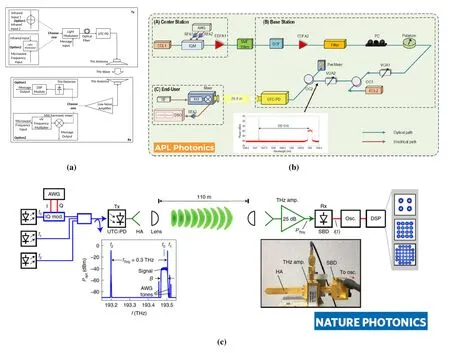
Figure 2.(a)shows the classic system architecture of the transmitter and receiver of a microwave photonics THz communication system.Signal generation and modulation in the light wave band are needed in the system,and detectors or mixers are usually used as key devices at receivers.(b)is the system architecture of[15],and(c)is the system architecture and received constellation of[16].
In addition to different system architectures,the design essentials and evaluation methods of the THz direct modulator,the core component of the THz direct modulation system,are also different from the mixing modulation THz communication mode and microwave photonics THz communication mode.The evaluation of the frequency converter is generally focused on the conversion loss,and for the direct modulator,insertion loss,the switch ratio and maximum phase shift are the most important parameters at present.This is because these three parameters are directly related to the formability of terahertz direct modulated waveforms and communication ranges.Only high formability and waveform precision can realize complex communication functions.
However,the greatest challenge for such a system lies in direct modulation technology.Since the terahertz frequency lies between the infrared band and the millimeter-wave band,the material responses in other frequency bands and the electromagnetic parameters brought by the structure are different,and thus the traditional modulation schemes of the optical band and microwave band are not completely suitable for the terahertz band.In recent years,terahertz direct modulation technology has received extensive attention.The focus of this paper is to analyze and illustrate the development of direct terahertz modulation technology.
III.THZ DIRECT MODULATION METHODS

Figure 3.The system architecture of the transmitter and receiver of a THz direct modulation system.THz sources can be generated through multiple methods,and there are several options for receiver key devices.The core of the system relies on THz direct modulators.
THz direct modulation communication technology is based on the development of terahertz modulation technology;however,it emphasizes high-speed communication systems.Since the initial study inNaturein 2006[18],terahertz modulation technology has gradually attracted attention,including terahertz amplitudes,phases,beams and other modulations.However,to be suitable for terahertz communication,the technology needs to meet the requirements of communication system interfaces and high-speed modulation.Thus,this article lists several THz direct modulation methods,including high-electron-mobility-transistorbased THz direct modulation,parallel-switch THz direct modulation,diode-based THz direct modulation,quantum cascade laser-based THz direct modulation and new-material-based THz direct modulation.
3.1 High-electron-mobility-Transistor-based THz Direct Modulation
High-electron-mobility-transistors(HEMTs)are a series of field effect transistors with high carrier mobility.At the heterojunction,a layer of two-dimensional electron gas with a thickness of 3-5 nm is formed,which restricts the carrier movement inside a plane.At present,HEMTs can be based on a variety of materials,such as GaN,GaAs,and InP.The intensity of the interaction between a terahertz wave and a twodimensional electron gas can be controlled by manipulating the gate voltage.Since the 2011OEproposal to regulate terahertz waves by combining a twodimensional electron gas with a microstructure[19],the performance of a modulator formed by the interlayer of a two-dimensional electron gas and metasurface has improved,which has led to an increase in the terahertz modulation rate from 10 MHz to 3 GHz[20]in recent years.
David Shrekenhamer et al.proposed a metamaterial-based spatial terahertz direct modulator in 2011[19],which achieved a modulation depth of 33% at 0.46 THz using a split-ring resonator.The structure is shown in Figure 4(a).A Drude model was used to fit the experimental results with the simulation results,which can be used to predict the future performance of HEMT direct modulators.In dynamic testing,the device achieved a modulation rate of 10 MHz,as shown in Figure 4(b).This report provided a brand-new concept for terahertz all-electric modulation.
In 2015,Yaxin Zhang et al.reported a metamaterial terahertz direct amplitude modulator based on HEMTs[22].The report used a HEMT to switch the metamaterial surface between two different dipole resonant modes,achieving a sine wave response speed of 1 GHz.The device had a maximum modulation depth of over 85%.The device could achieve a good eye pattern with a maximum frequency of 200 MHz.This report proved for the first time that a spatial direct modulator could be used as a key device in terahertz communication systems with such a high data rate,which provided a new degree of freedom for the construction of terahertz communication systems.
In 2017,Zhen Zhou et al.reported a HEMT-based modulator[23].The modulator was a metasurface composed of an array of symmetric quadruple-splitring resonators.The switch ratio reached 80% while working as an amplitude modulator at 0.86 THz,and the phase shift could reach 0.67 rad while working as a phase modulator at 0.77 THz.In dynamic testing,the direct modulator reached a 2.7 MHz modulation speed.Based on the response of different frequency bands at the metasurface,this paper proposed a metasurface that could be used for different modulators in different frequency bands.

Figure 4.(a,b)show the meta unit shape,HEMT structure and output spectrum of the metasurface in[19].(c)shows the structure,and(d)shows the phase shift performance of the modulator proposed in[21].The structure and state-modulation simulation results in[20]are shown in(e,f),and its dynamic performance is shown in(g).
In 2018,Xiaoyu Zhang et al.proposed a dynamic metasurface terahertz direct modulator based on HEMT[24].The unit cell of the metasurface was a grid-shaped structure that modulated terahertz waves by changing the gate voltage of the HEMT to vary the surface current distribution.In static experiments,the transmission of the on state and off state at 0.835 THz could reach 0.61 and 0.41,respectively,realizing a 33%switch ratio.In addition,by replacing a square wave with the DC signal,a switch ratio of 23%could be achieved when the frequency of the modulated square wave reached 20 MHz.The report confirmed that the HEMT was an ideal candidate for terahertz ultrafast metasurface direct modulator design due to its low parasitic resistance and capacitance characteristics.
Yaxin Zhang et al.reported a THz direct phase modulator based on a HEMT metasurface in 2019[21].This meta unit was enhanced by coupling dipole resonances and LC resonances together.The transmission amplitude and phase were investigated using the Kramers-Kronig relation,and the simulation and experiment were well matched.An equivalent circuit was also given,which was very consistent with the 3D electromagnetic model.This device reached a phase shift up to 137° in the experiment at 0.352 THz,and a 30 GHz bandwidth with a phase shift larger than 130°.The structure and result can be seen in Figure4(c,d).This paper predicted and realized direct large phase modulation in the terahertz band by means of inter-resonance enhancement,which provided a good foundation for terahertz direct modulation systems.
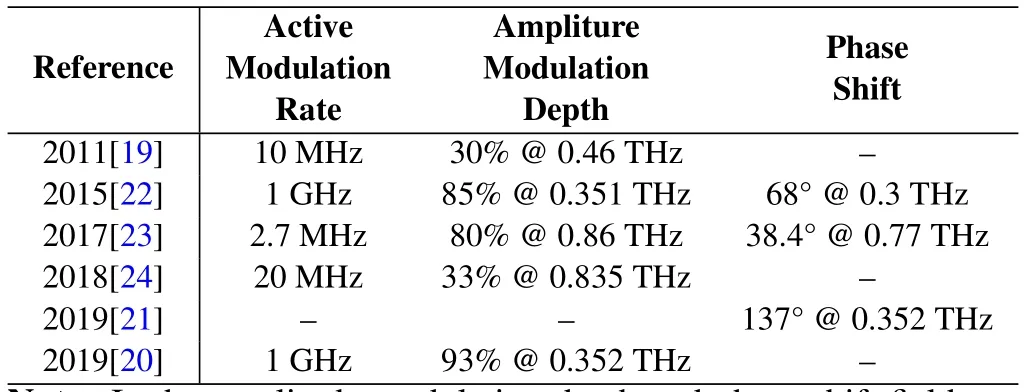
Table 1.Key parameters of mentioned HEMT-based THz direct modulators.
Yuncheng Zhao et al.reported a communication system based on a THz direct modulator in 2019[20].The modulator manipulated the incident THz wave by turning on and off switches made up of HEMTs on the metasurface.This design considered the connection of meta units instead of considering resonances or states inside a single meta unit.This THz direct modulator sorted meta units into groups and then turned on or off groups of units.Through regular sorting and switching,at least four different states were discovered on a single meta surface.By switching among the states,this modulator could reach a 93% modulation depth at approximately 0.352 THz,as shown in Figure 4(f).The communication speed was tested;this modulator supported up to a 3 GHz sinusoidal control signal,and the-3 dB bandwidth was approximately 1 GHz.The structure and experimental results are shown in Figure 4(e,g).This report verified the feasibility of a terahertz metasurface communication system by considering the group effect of the metasurface and provided a new concept for the future design of terahertz metasurfaces.
The advantage of this kind of modulator is that it can combine two-dimensional electron gas with metastructures and modulate terahertz amplitude and phase in a free-space quasi-optical mode,on-chip microstrip mode or waveguide mode,which is more flexible and has less insertion loss.
3.2 Parallel-switch THz Direct Modulation
Parallel-switch direct modulators usually have several identical active devices in parallel on the main transmission line.The structure and its working mechanism are shown in Figure 5(a).Instead of working in the resonant state,parallel-switch direct modulators work in a wider banded state.By turning off all the parallel switches,the switches act as capacitors,and the main transmission line acts as inductors.The capacitors and inductors are set in a topological structure of a distributed transmission inequivalent LC circuit where THz waves can transmit perfectly.By turning on all the parallel switches,the main transmission line is shorted,and most of the energy about to prorogate in the main transmission line is reflected.Due to this unique mechanism,parallel-switch direct modulators tend to have a wider working bandwidth than resonantbased modulators.
In 2012,Ryuichi FUJIMOTO et al.reported a 120 GHz OOK direct modulator based on a 65-nm CMOS with a 9-Gbps rate[25].The modulator is made up of two switches parallel to the main transmission line.The electric length between the switches is set to a quarter of the wavelength at the first instance.As seen in Figure 5(b),when the switches are turned on,the input is grounded at the first switch where the impedance is near zero.After a quarter transmission line conversion,the impedance becomes near infinite.Then,there is another switch turned on,grounding the main transmission line.These two switches mitigate the effect of the input on the output,and the modulator is shut down in theory.When the switches are shut down,the input signal can transmit through the main transmission line,and the modulator is open in theory.However,a quarter of the wavelength is too long,and the transmission loss will be considerable when the switches are shut down,so the length of the transmission line is optimized to a much shorter length.The output power is measured using a D-band power meter in two different states,and the results show that the output power is-17.3 dBm in the‘ON’state and-34.6 dBm in the‘OFF’state,which means that a 17.3 dB switch ratio is reached at 120 GHz.A photo of this modulator is shown in Figure 5(c).According to this report,only two active devices were used to realize a switching ratio of 17.3 dB by combining circuit theory with electromagnetic simulation,and the performance and system complexity were also considered to meet the requirements of a large amount of terahertz direct amplitude modulation.
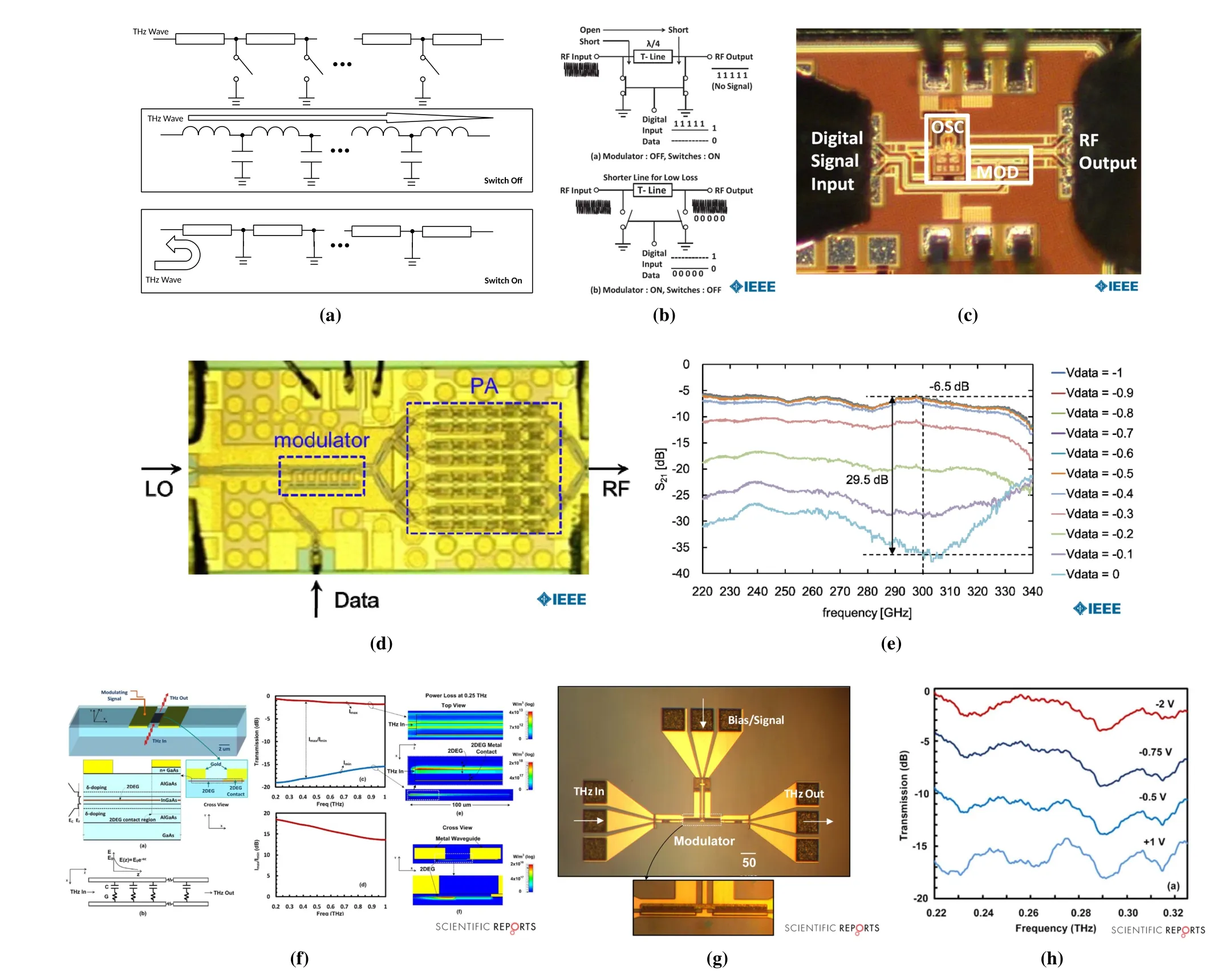
Figure 5.(a)shows the schematic of parallel-switch THz direct modulators in both the on and off states.In the on state,the modulator’s equivalent circuit shows a transmission line-like structure that supports good transmission of THz waves,and in the off state,THz waves can be effectively blocked out of the device.(b,c)Schematic and photograph of the transmitter proposed in[25].(d,e)shows the photo and transmission-VS-control voltage of the device in[26].(f)shows the mechanism and structure of the direct modulation shown in[27],and(g,h)shows the photo and experimental results of the device.
Hiroshi Hamada et al.proposed a 300 GHz ASK THz direct modulator in 2015 based on InP-HEMT MMICs[26].Six HEMTs are installed parallel to the main transmission line,acting as switches connecting the main transmission line to the ground.The transmission line connected to the gate of the HEMTs is optimized to reach lower group delay fluctuation.The measured group delay fluctuation was approximately±3.9 ps in the modulation frequency band.The modulator could reach a-6.5 dB insertion loss and a 29.5 dB switch ratio in static measurement,which can be seen in Figure 5(e).A photo of the device is shown in Figure 5(d).In this design,the group delay of the amplitude modulator was well controlled by the parallel-switch scheme,which reduced the burden on the baseband and receiver and provided a solution for ultrahigh-rate terahertz direct modulation communication.
P.K.Singh et al.reported a parallel-switch THz direct modulator in 2017[27].Instead of using discrete switches,the modulator used a long HEMT parallel to the transmission line,which was equivalent to countless small switches parallel to the transmission line.Its working mechanism and simulation results are shown in Figure 5(f).This structure reduced the repetition period.Its topology structure and lumped LC circuit equivalent topology structure of an ideal transmission line were more similar to those of traditional parallel-switch THz direct modulators,which further optimized the transmission performance.The modulation index of this device reached 0.71 under 0 dBm drive power,and the modulation bandwidth was 14 GHz with the limitation that the modulation index was higher than 70% of its maximum.A photo and experimental results are shown in Figure 5(g,h).Although this device used a HEMT,its working principle was different from those works in the‘high-electronmobility-transistor-based THz direct modulation’section.In the paper presented by Singh P K et al.,the device worked through the principle of switching between the transmission line state and reflection state.For this reason,we believe it is better to put this report in this section.This report also showed that parallelswitch THz direct modulators are capable of using a variety of different active devices,implying their strong adaptability to various processing techniques.
Tanjil Shivan et al.proposed a highly linear singlepole-double-throw(SPDT)switch-based terahertz direct modulator in 2019[28].This work addressed the on-chip switching requirements of the D-band system,enabling high-power ultrahigh-speed T/R and MIMO switching applications in the 90-170 GHz band.The design used double heterojunction bipolar transistor(DHBT)monolithic microwave integrated circuit(MMIC)technology for an InP and considered both isolation and linearity.In small signal measurements,the switch ratio could reach 42 dB.In a large-signal experiment,the insertion loss of the device reached a stable value of 3.5 dB when the input power was lower than 12 dBm.This is the first InP DHBT MMIC SBDT switch covering the 90-170 GHz band.Under the same frequency band,its bandwidth and isolation are better than those of CMOS,GaAs and SiGe PIN diodes,and SiGe HBT technologies.
In 2020,Yunshan Wang et al.proposed a terahertz traveling-wave type switch transceiver using 65 nm CMOS technology[29].A lossless shunt capacitor was used as a parallel MOSs’equivalent circuit in a traveling wave switch.The design referred to a topology that could effectively improve the isolation with fewer transistors,and by folding the transmission line,par-asitic parameters could be overcome.The cutoff frequency of this topology could be increased to more than 200 GHz.In the measurement,the travelingwave-type switch could achieve a near-10 dB switching ratio at 200 GHz.In a data transmission experiment,the link could realize an error-free transmission rate of 7.5 Gbps.

Table 2.Key parameters of mentioned Parallel-switch THz direct modulators.
The structure of parallel-switch THz direct modulators can be well combined with the on-chip integration process.These devices have low power consumption,high switching rates,low insertion loss and low group delay.They are suitable for broadband IF signals and can be integrated with amplifiers.This is a potential scheme for the high mobility and miniaturization of terahertz direct modulation communication systems in the future.
3.3 Diode-based THz Direct Modulation
A diode-based modulator uses a low-frequency signal to control its switching,thus controlling THz wave transmission.One popular diode used in THz modulators is the Schottky diode.The main effect structure in the Schottky diode,the Schottky contact,consists of metal and a doped intrinsic semiconductor,and a Schottky barrier is then formed on this contact surface.Schottky diodes are one of the most commonly used diodes in the THz band due to their low junction capacitance[9].The Schottky diode’s total capacitance is at the femto farad level,which guarantees its fast response time.
This kind of device mainly uses three ways to realize the high-speed modulation of terahertz waves.First,it uses the transistor structure directly.Second,the transmission line is used as part of the modulation structure.Third,the quasi-optical structure is used to utilize the Schottky diode’s dynamic characteristics.These methods simplify the structural design and guarantee a good modulation effect.
In 2013,Naser Alijabbari et al.reported a single-port phase-direct modulator based on Schottky diodes[30].In this paper,a waveguide structure was used.The effective structure of a quartz microstrip circuit in the cavity was controlled by different feeds,turning Schottky diodes on and off to adjust the phase of the output reflection parameters for the whole structure.The structure is shown in Figure 6(a).The device can achieve 180-degree phase modulation at approximately 200 GHz with 8-10 dB return loss.The simulation and experimental results are shown in Figure 6(b).This report further proved that Schottky diodes could be used as core devices for a terahertz direct modulator to effectively control the reflection characteristics of terahertz waves.
Fei Fan et al.proposed a terahertz direct modulator based on Schottky grating arrays in 2014[33].This design used a two-dimensional fin-line structure to feed the terahertz wave into a dual Schottky plasmonic crystal waveguide.By controlling the cross finger-like Schottky contact,the conductivity distribution in the whole structure was switched between two different structures to regulate terahertz waves.This design achieved a maximum modulation depth of 15 dB within a 2.2-3.2 THz frequency range in static tests with applied voltages from-15 V to+15 V,thus enriching the methods for the design of Schottky terahertz direct modulators.
In 2016,Yang Bai et al.proposed a terahertz quasioptical modulator based on a hybrid structure[34].The modulator used two groups of Schottky junctions in the form of metastructures that were independently controlled and spatially cross-distributed.The resonance mode of the incident terahertz wave on the surface could be controlled by applying voltage to these two groups of structures independently.The design achieved a modulation depth of approximately 46%at 0.95 THz and predicted a dynamic regulation bandwidth of approximately 0.27 MHz.The design used two interwoven distributed but independently controlled structures to control the terahertz wave,which increased the degree of freedom for the design of terahertz quasi-optical modulators.
In 2016,Sami Hawasli et al.reported a direct terahertz phase modulator based on a bow-tie antenna[35].This report used a 10×10 structure with a unit combining a bow-tie antenna and Schottky contact to regulate THz waves and finally achieved a 20° phase shift at 1.6 THz.
Wenchao Min et al.proposed a multifrequency terahertz direct modulator in 2016[36].The modulator shaped one Schottky electrode using two kinds of metastructures with different resonant frequencies,which enabled the structure to tune terahertz waves at 0.58 THz and 1 THz when activated.Through experiments,the structure finally achieved modulation depths of up to 50% and 85% at 0.61 THz and 1.03 THz,respectively.This design provided a method for the dynamic regulation of terahertz broadband and multifrequency metamaterials from another point of view.
Nicholas Karl et al.reported a substrate waveguidebased direct modulator in 2017[31].Unlike traditional designs that turn on and off Schottky diodes to change the resonant mode on metallic structures,this design spread Schottky junctions over the whole substrate and used them to manipulate the modes inside the substrate,as shown in Figure 6(c).A Schottky contact was combined with metastructures in this device,and the surface was relatively hard to characterize due to the complex pattern and the nonuniformity distributed epilayer conductivity.The equivalent surface property was extracted using ellipsometry.With this scheme,a large phase shift up to 0.8 rad/mm in the terahertz band was predicted,which can be seen in Figure 6(d).The report predicted the potential of terahertz direct phase modulation in a novel framework,providing researchers with a new way of thinking.
In addition to Schottky diodes,resonant tunneling diodes(RTDs)are also popular in THz direct modulation.A RTD is a kind of diode with two potential barriers and a potential well between them.Due to its unique structure,the relationship between its voltage and current is not monotonic,which means that it can exhibit negative conductivity characteristics when a specific voltage bias is applied,which is highly suitable for oscillators.If the DC bias of the resonant tunneling diode changes,the output power will also change.Unlike other direct modulators,where the local oscillator source and the modulator are physically separated,RTD-based direct modulators combine the modulator and THz source and can directly adjust the output power by directly feeding the control signal into the RTD DC bias.

Figure 6.(a,b)are the structure and result of[30],the dots are the experimental results and the line is the simulation result.(c)is the structure proposed in[31],and(d)is the estimated phase shift of the device.(e,f,g)shows the structure,photo and eye pattern of the modulator shown in[32].
In 2017,Naoto Oshima et al.reported an RTDbased direct modulator[32].Four oscillators were used to generate both THz waves at 500 GHz and 800 GHz on a single chip.The schematic and photo are shown in Figure 6(e,f).The reported chip could generate 4 channels of signal in frequency division multiplexing(FDM)and polarization division multiplexing(TDM)schemes.The leakage between the channels was less than 30 dB,and the transmission rate could reach 28 Gbps.The experiment results can be seen in Figure 6(d).This report integrated four different channels on a single chip,showing that multiple channels did not reduce the system integration level,which increased the confidence in terahertz direct modulation MIMO research.
Abdullah Al-Khalidi et al.proposed two terahertz oscillators using an RTD in 2018[37].The dynamic performance of an RTD with different equivalent bypass capacitors was compared in this design,and it was found that the oscillator bandwidth of an RTD with low equivalent bypass capacitance is extremely wide.The team then loaded an eye pattern signal with a maximum frequency of 13 Gbps on a terahertz wave by changing the RTD bias voltage,achieving a maximum output power of 1 mW at 260 GHz.The design showed that the high speed of RTD terahertz direct modulators must be supported by dynamic devices with small parasitic parameters.

Table 3.Key parameters of mentioned Diode-based THz direct modulators.
3.4 Quantum Cascade Laser-based THz Direct Modulation
A terahertz quantum cascade laser(QCL)is a very important laser source in the 1-5 THz band.In terms of the working principle,it is a single-pole device with only electrons involved.Therefore,its response speed can be very fast in modulation,and it is a promising signal source for 1-5 THz band high-speed communications.A terahertz QCL is a semiconductor laser.THz QCL direct modulation is mainly limited to the current modulation technology and laser performance.Most QCL-based direct modulators work in the amplitude modulation state.In general,direct modulation technology for terahertz QCLs can be achieved in three ways.The first way is to set an appropriate voltage bias so that the output power and the input control voltage maintain a linear relationship,and the output terahertz laser changes linearly with the control signal.The second way is to make the device work near the radiation threshold by setting a specific bias voltage.When an additional voltage is fed in,a terahertz laser that varies with the additional voltage can be generated.When the additional voltage is zero,there is no terahertz laser output.The third way is to change the driving voltage of the laser to achieve the radiation frequency and demodulate the loaded signal by using the signal difference formed on the detector by the difference in laser frequency.
Wireless signal transmission and communication demonstrations based on a terahertz QCL have mainly focused on several frequency points with high transmittance in an atmospheric environment.Unlike other direct modulation communication systems,the demodulator principle of a THz QCL is not based on mixers or detectors,so demodulation systems will also be presented in the following pages.The related demonstration systems and modulation technologies are introduced below.
In 2011,Z.Chen et al.used a terahertz quantum cascade laser with pulsed radiation as the transmitter and a terahertz quantum well detector as the receiver to demonstrate the transmission of wireless audio signals with a carrier frequency of 4.1 THz and a transmission distance of 2 m[40].The demonstration process used an analog audio signal direct modulation technique.The terahertz quantum cascade laser output terahertz lasers whose power varied with the audio signal amplitude.Then,the THz signal was received by a terahertz quantum well detector and directly fed into a speaker after demodulation and amplification.This direct modulation method used THz QCL output power in the linear range,making the change in the bias and output THz power present a linear correlation,thus ensuring the fidelity of the audio signal as much as possible during transmission.
In 2014,Qingzhao Wu et al.adopted the OOK modulation method[38].By applying a small voltage signal onto a working near-threshold voltage terahertz quantum cascade laser,the amplitude modulation of the laser finally achieved a 100% modulation depth and finally obtained a 30 MHz identifiable bandwidth of square waves at a distance of 0.5 m.The system structure and experimental results are shown in Figure 7(a,b).In 2015,Li Gu et al.took a similar approach to improve the error-free signal transmission rate of a link up to 20 Mbps at a carrier frequency of 3.27 THz and transmission distance of 2.2 m by optimizing the impedance matching,modulation circuit and performance of a transimpedance amplifier circuit of a terahertz quantum cascade laser[39].The experiment results can be seen in Figure 7(c).
To further verify the communication performance of the device,in 2017,Zhiyong Tan et al.adopted transmission line packaging combined with bias tee signal loading technology to realize the direct detection of a fast modulated terahertz laser[41].The system worked at 4.2 THz.By setting the bias,the terahertz quantum cascade laser worked in the linear region.The receiver used the frequency matched terahertz quantum well detector,which provided fast detection.The limit data rate of the system could reach 500 MHz.A 30%eye pattern open coefficient of sine waves could be achieved under a transmission rate of 300 MHz,which rose to 82%when the rate fell to 100 MHz.

Figure 7.(a,b)shows the structure and experimental results proposed in[38],and(c)shows the result of[39].
Generally,the demonstration experiment mentioned above only verified the most basic performance of wireless communications using a terahertz quantum cascade laser in the 1-5 THz range.Limited to the development of devices(such as low output power and poor beam quality)and imperfect impedance matching of devices in demonstration systems,QCL-based THz modulation systems still have room for improvement.To promote the development of 1-5 THz band wireless communication technology,the output power of the device needs to be increased,and the structure of the material in the device needs to be taken into consideration.The impedance matching characteristics of the device must be considered in the packaging process to ensure that the high-speed response characteristics of the core device can be fully used.
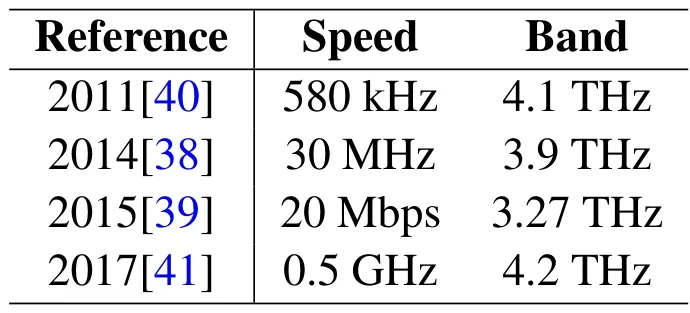
Table 4.Key parameters of mentioned QCL-based THz direct modulators.
3.5 New-material-based THz Direct Modulation
In addition to active semiconductor terahertz modulators using electric control signals,new materials using other physical fields to control THz waves also show great potential,including phase-change materials such as vanadium dioxide and 2D materials such as graphene.Their feasibility for terahertz wave amplitude and phase control has been verified experimentally.
A terahertz phase-change modulator is a device that uses an external physical field to control the phase change of a material to change its properties and regulate the terahertz wave.Phase-change materials are a series of materials that can be transformed from one phase to another.Vanadium dioxide(VO2)is a very representative and promising phase-change material.It can achieve a reversible metal-insulator transition at approximately 340 K,resulting in abrupt changes in optical and electrical properties.Such a phase transition can be induced by light,heat and electricity.In addition,the phase transition can be completed in femtosecond time,making it possible to be applied in high baseband rate scenarios.
Gaochao Zhou et al.reported a broadband and high modulation depth THz modulator in 2017[45].The proposed metasurface works at 68°C.By controlling the current flowing inside the metasurface,the temperature of vanadium dioxide over the surface changed,resulting in a phase transition.The phase transition gave the device the ability to tune THz wave transmissions continuously from over 78%to below 28%from 0.3 THz to 1.0 THz.The report coupled two different types of thermoelectric effects together to regulate terahertz waves in another dimension.
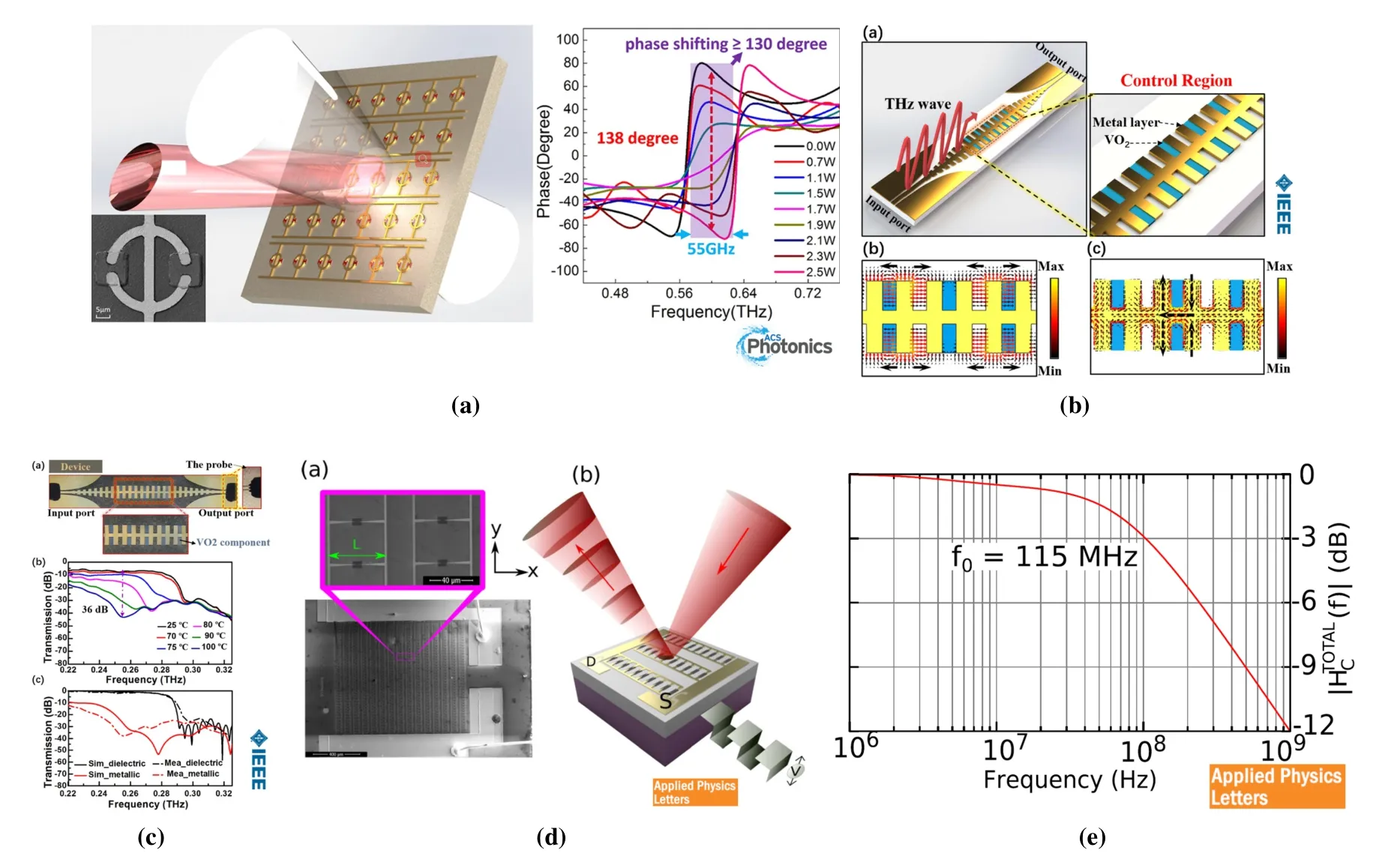
Figure 8.(a)shows the structure and phase shift performance of the vanadium dioxide-based direct modulator mentioned in[42].(b)shows the structure and resonant mode of the SSPP proposed in[43],and(c)shows the photograph and performance of the modulator.(d,e)shows the photo,system setup and dynamic performance of[44].
In 2018,Xudong Liu et al.reported a metasurface based on vanadium dioxide and a metal grating for terahertz polarization modulation[46].Under an appropriate incident angle,grating direction and incident polarization,the device could achieve an average modulation depth of 99.75% within the range of 0.2-1.1 THz under specific output polarization through polarization conversion,and the reflected wave of the device could also be switched between a p-linear polarization wave and a circular polarization wave within the range of 0.8-1.5 THz.The device used vanadium dioxide to realize the polarization modulation function in a broadband application,which provided a new theoretical method for terahertz multifunctional direct modulation.
Yuncheng Zhao et al.proposed a THz direct phase modulator using vanadium dioxide coupling nanostructures in 2018[42].The metastructures were ringdumbbell composite resonators combined with vanadium dioxide.The vanadium dioxide could be tuned by a casting laser.Different laser powers resulted in different resonant modes of the metastructure.Using this spatial phase direct modulation device,an over 130° phase shift could be reached in the 575-630 GHz range,and a maximum phase shift up to 138°could be reached at 600 GHz,as shown in Figure 8(a).In this paper,a large phase shifter using terahertz direct modulation technology was proposed,and a large working bandwidth was reached.
Ting Zhang et al.mixed a phase-transition material with spoof-surface-plasmon-polaritons(SSPP)together and reached a maximum 36 dB switch ratio in the range of 0.22 THz to 0.28 THz in 2019[43].This design was composed of a double-sided corrugated strip transmission line and vanadium dioxide films located inside the grooves of the transmission line.When the phase of vanadium dioxide changed,the repetition period of the SSPP structure changed,and thus,its dispersion characteristics differed,resulting in different transmission factors.By manipulating the cutoff frequency of the structure,a relatively large switch ratio could be reached.The scheme of adjusting the dispersion effect could effectively control broadband amplitude transmission.The structure,photograph and results are shown in Figure 8(b,c).
Another approach involves 2-dimensional materials.These material have only one layer of atoms and include graphene and transition metal sulfides.These materials have variable conductivity when given different external voltages or different laser power feeds.
Taking graphene and electric control as an example,when zero bias is applied,the Fermi level is at the Dirac point.When a nonzero voltage is applied,the Fermi level shifts away from the Dirac point,leading to a significant change in surface conductivity.By patterning graphene and metallic surfaces,the effective resonant part of a structure can be changed while applying different voltages,thus giving the degree of freedom to control transmission or reflection.In addition,graphene has extremely high electronic mobility,making THz direct modulation possible.
A terahertz graphene-based amplitude modulator was reported by D.S.Jessop et al.in 2016[44].The device was built up by bow-tie antenna arrays,and graphene in the shape of a rectangle was used to connect the antennas,providing tunable resistance,which can be seen in Figure 8(d).The modulation depth and cutoff frequency were investigated at 2 THz,reaching a>25% modulation depth in theory,and a 105±15 MHz optical modulation cutoff frequency was reported,as shown in Figure 8(e).
Zhaoyang Liu et al.proposed an optically controlled terahertz direct modulator based on diarylethenegraphene in 2017[47].The device could achieve up to 20%reversible capacitance modulation in the terahertz band.The special structure of the device enabled the response speed to the optical control signal to be four orders of magnitude faster than a conventional sandwich capacitance.Significant conductivity differences could be seen in the range of 0.4-2 THz.The design tuned the terahertz capacitor effectively,providing a new structure for terahertz direct modulation.
Zefeng Chen et al.proposed a graphene-based terahertz wave Brewster angle direct modulator in 2018[48].When the incident angle was 68°,the reflected signal could be reversed by changing the voltage applied to the graphene.By studying the time-domain waveform during the controlling voltage change process,the team found that the peak-peak value of the waveform dropped from 1.37 to 0.067 when the incidence angle was 65°.Through frequency domain analysis,the modulator could achieve at least a 99.3%modulation depth at 0.5-1.6 THz working in an amplitude modulation state.The team also analyzed the phase modulation performance at an incident angle of 68° and found that at 0.4 THz,a phase shift of 180° could be achieved,and a phase shift of 140°could be generated when the frequency was near 1.6THz.Moreover,the correspondence is also broadband.By proposing a wide-band modulator with high modulation efficiency using the principle of graphene regulation of Brewster angle,this team demonstrated graphene’s potential in terahertz direct modulation applications.
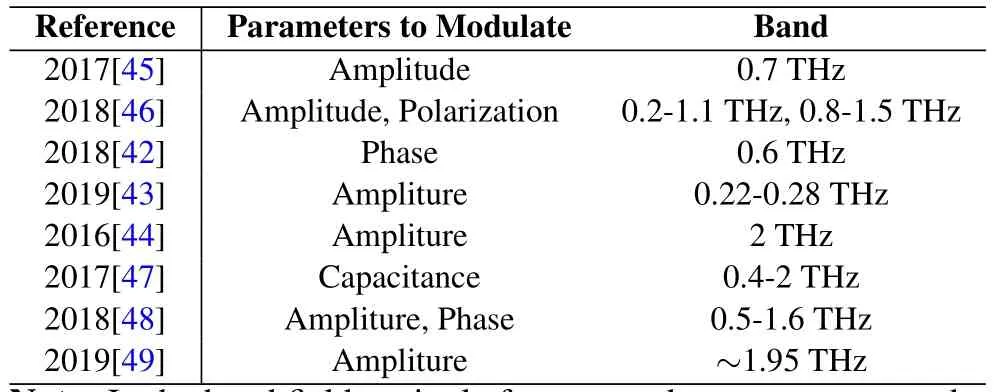
Table 5.Key parameters of mentioned New-material-based THz direct modulators.
In 2019,Arash Ahmadivand et al.reported a hybrid graphene island-mediated metasurface that achieved tunable charge transfer plasmon resonances[49].This report demonstrated that in a graphene-metal hybrid structure,tuning the conductivity of the graphene connection between metal islands could effectively change the resonant mode of the whole structure.The rising edge and falling edge of the modulator were 19μs and 21μs,respectively,the modulation depth was 72%,and the modulation bandwidth of 3 dB could reach 22 kHz.This design provided a new way of designing terahertz graphene-based direct modulators.
New material-based modulation is an important developing direction of terahertz direct modulation.However,it also faces the challenge of further optimizing the material system,further improving the performance of the modulation speed and developing modulators fitted for terahertz communications.Its research towards high-speed,light-weight and industrialization is still one of the highlights in terahertz communication science at present.
IV.SUMMARY
This paper focuses on terahertz direct modulation technology,including high-electron-mobilitytransistor-based THz direct modulation,parallelswitch THz direct modulation,diode-based THz direct modulation,quantum cascade laser-based THz direct modulation and new-material-based THz direct modulation.Each method has unique characteristics and fits different scenarios.Table 6 summarizes their characteristics and advantages.
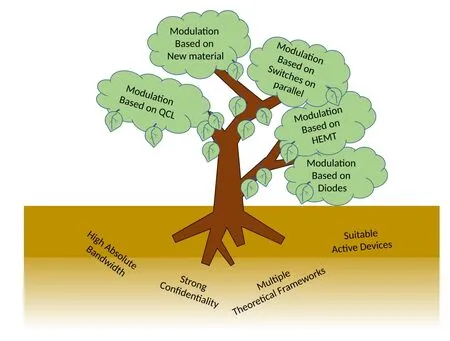
Figure 9.Due to the nature of high absolute bandwidth and strong confidentiality in the THz band and the multiple theoretical frameworks and suitable active devices for THz direct modulators,multiple styles of THz direct modulators are experiencing rapid growth on the fertile soil of the THz band.The representative designs are mainly based on high-electron-mobility-transistor-based THz direct modulation,parallel-switch THz direct modulation,diode-based THz direct modulation,quantum cascade laser-based THz direct modulation and new-material-based THz direct modulation;other methods are constantly appearing in the meantime.
Although a variety of terahertz direct modulators have emerged,their development still cannot fully meet the needs of terahertz frequency band communication,so this article provide perspective on the aspect of high-performance THz direct modulation,multifunctional THz direct modulation,on-chip THz direct modulation,digital-coded THz direct modulation and THz direct modulation using new materials.
(1)High-performance THz direct modulation
High-performance terahertz direct modulation technology includes high data rate modulation,high depth modulation and large phase modulation.
At the client end,an increasing number of mobile communication devices and computing resource sharing services carried by people will require more communication bandwidth.At the base station end,the geometric growth in intelligent devices and Internet communication requirements also require the development of high-speed terahertz modulators.Acting as a center node,a base station launches several times more information than a single user.Thus,more densely arranged base stations will have to deal with the explosive growth in the data stream,which will also impose higher requirements on the data rate of the base station.
In addition to increasing the code rate,the amount of information that can be carried on each code is also important.Only with the help of higher depth modulation and larger phase modulation can more information be loaded on the unit symbol to achieve a high communication rate.According to Shannon’s formula,to achieve a high data rate,a terahertz direct modulator needs to work at higher power to improve the signal-to-noise ratio;on the other hand,sufficient operating bandwidth is also needed.Quasi-optical direct terahertz modulation is currently one of the most promising technologies and uses methods such as dynamic metasurfaces to distribute high terahertz power over tens of thousands of dynamic devices so that each active device receives a reasonable amount of power.Due to wavelength limitations,the relative bandwidth of electrical devices has difficulty reaching an ultrahigh value.Therefore,on the one hand,transmission lines and other devices with lower dispersion are needed to ensure that the physical wavelength corresponding to the terahertz waves with wider bandwidth is within a controllable range.This can be obtained by metastructures or two-dimensional materials with editable dispersion curves.On the other hand,a higher operating frequency is required to ensure a larger absolute bandwidth for a device under the same relative bandwidth,which needs a terahertz device with lower parasitic parameters and higher carrier mobility to ensure a higher operating frequency,which can be achieved by HEMTs or Schottky diodes with low junction capacitance.
High-depth terahertz modulation requires that the dynamic range of the core device be sufficiently large.For example,when a varactor diode is loaded with different voltage signals,its impedance points should have a sufficient spacing distance with each other on a complex plane,which means that the active range of the variable capacitance should be sufficiently large.Due to the lack of gain devices in the terahertz frequency band,only when the dynamic range of the core parameters is large can the whole device achieve a high switching ratio with a core packed in a lossy environment.In regard to phase,large phase modulationalso requires good core parameters because the two points with maximum amplitude changes correspond to opposite phases on the Smith chart.
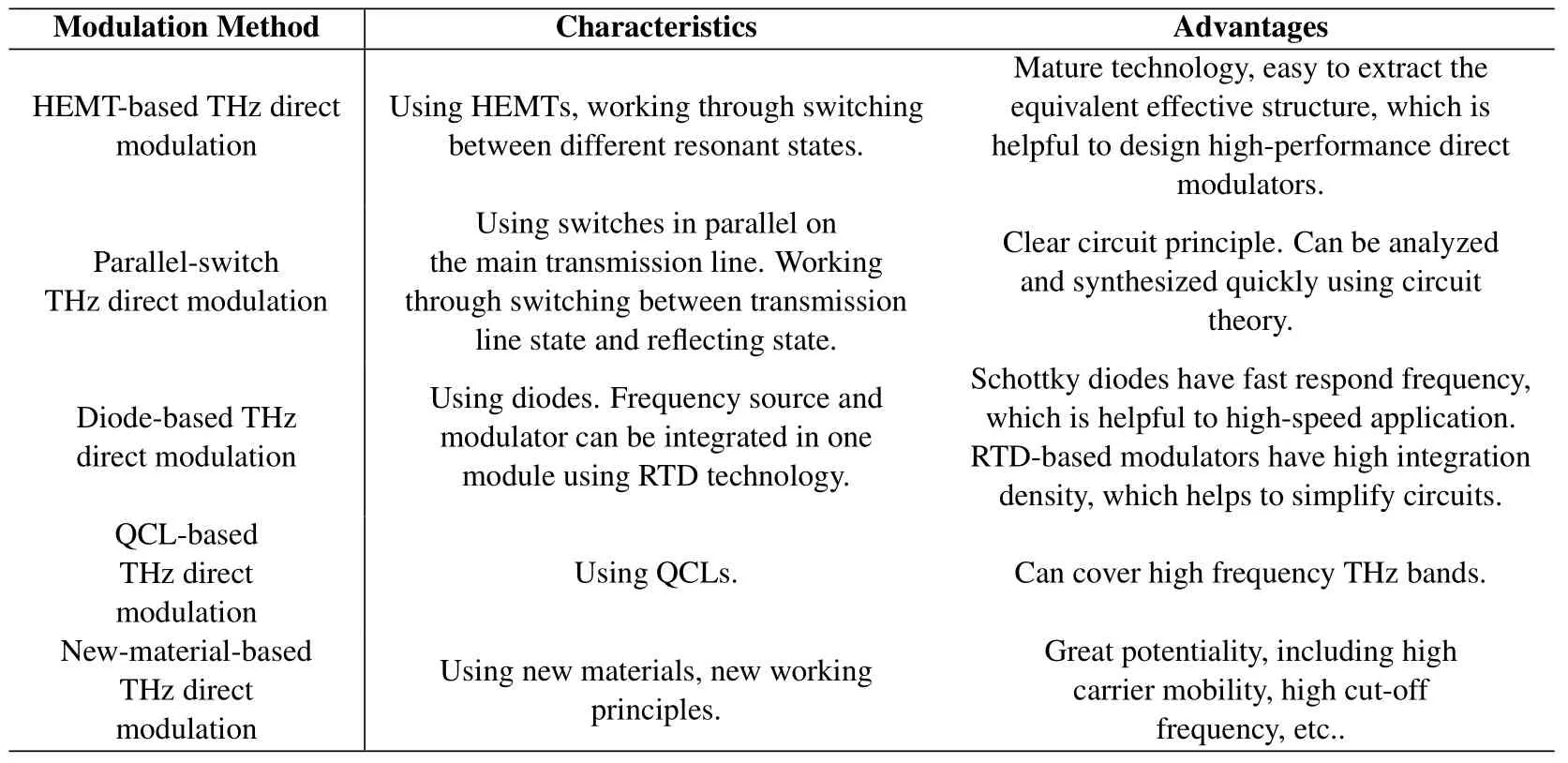
Table 6.Characteristics and advantages of different THz direct modulation methods.
(2)Multifunctional THz direct modulation
Multifunctional terahertz direct modulation includes amplitude modulation,phase modulation,beam modulation,and orbital angular momentum modulation.The modulation of amplitude and phase is necessary for information transmission.If only one method of modulation(amplitude or phase)is used,after transmission in a two-dimensional Gaussian white noise channel,there must be a dimension on the constellation diagram with no point of tangency between the scattered envelope of adjacent constellation points due to the noise when received,which also means there is a waste of the complex plane,leading to low carried information at the same transmission power compared with a method combining amplitude or phase modulation.
In addition to meeting the demands of point-to-point fixed station communication,the demands for pointto-point mobile station communication will inevitably increase with the miniaturization and increased mobility of terahertz communication equipment.Unlike fixed stations,mobile stations need to track the positions of both users in real time and carry out beam tracking.The spacing of the phased array used for beam tracking must be less than half the wavelength to maintain a no grating lobe condition.The short wavelength in the terahertz band means that tracking in the terahertz band requires placing multiple transmitter components in an extremely small space.For a terahertz direct modulator,if the communication module and the phase control module can be integrated on the same modulator,the system complexity can be greatly reduced,and a simpler system architecture can be realized.
For the application of near-field communications,such as database access in a data center,the orthogonal quantity of the electromagnetic wave propagation mode is not limited to horizontal and vertical polarization or left-handed and right-handed polarization.The different orbital angular momentum can also be an orthogonal mode in wireless channels.Modulation of the orbital angular momentum in the THz band can achieve more information channels in a limited space,thus achieving several times the data rate.Therefore,the terahertz direct modulator needs to combine amplitude,phase,beam and orbital angular momentum modulation to adapt to new scenarios and new requirements in the future,packing the communication and tracking system with multiple channels inside a single THz direct modulator.
(3)On-chip THz direct modulation
Terahertz direct modulators mostly adopt quasioptical direct modulators or direct modulators encapsulated in a cavity with low conversion efficiency,which will lead to excessive physical space occupied by the modulator and low degree of integration.Some existing works combine THz direct modulators with semiconductor technology,such as GaAs and InP,or use mature and modular CMOS technology,greatly reducing the volume of the THz direct modulator system and greatly improving the module simplicity.As these systems can promote THz direct modulation communication systems to be deployed in future personal mobile users,the commercialization of future THz communication systems,as well as THz direct communication systems,will boom.
(4)Digital-coded THz direct modulation
The digital encoding of a THz direct modulator means that the modulator needs to realize the transmission of multiuser and multibit information in the time of a single clock signal.This can significantly improve the speed of the THz direct modulation communication system and enrich its function.If the multifunctional terahertz direct modulator mentioned above can be coded digitally,multinary QAM transmission,multiuser transmission through a coded beam and multichannel transmission through coded orbital angular momentum can be derived.The existing lownary,unicast,low-speed THz direct modulation communication system can evolve into a high-nary,multicast,high-speed THz direct modulation communication system though the application of digital encoding of THz direct modulators.
(5)THz direct modulation using new materials
Currently,the performance of a THz direct modulator is essentially determined by the dynamic characteristics of the material.However,with the development of material science,an increasing number of new materials suitable for the terahertz frequency band are emerging.Because of the extremely high electron mobility of graphene,it is considered a promising terahertz dynamic material.Only with the help of new materials can terahertz direct modulators advance with the times,making the terahertz direct modulation system an indispensable part of people’s work and life in the future.
ACKNOWLEDGMENT
This work is supported by the The National Key Research and Development Program of China under Contract No.2018YFB1801503,National Natural Science Foundation of China under Contract Nos.61931006,61921002,61771327,61927813,61775229,61991430 and 62022022.
- China Communications的其它文章
- AI Assisted PHY in Future Wireless Systems:Recent Developments and Challenges
- Secrecy-Enhancing Design for Two-Way Energy Harvesting Cooperative Networks with Full-Duplex Relay Jamming
- Adaptive Maxwell’s Equations Derived Optimization and Its Application in Antenna Array Synthesis
- A 16-QAM 45-Gbps 7-m Wireless Link Using InP HEMT LNA and GaAs SBD Mixers at 220-GHz-Band
- A Wideband E-Plane Crossover Coupler for Terahertz Applications
- A Semi-Blind Method to Estimate the I/Q Imbalanc of THz Orthogonal Modulator

